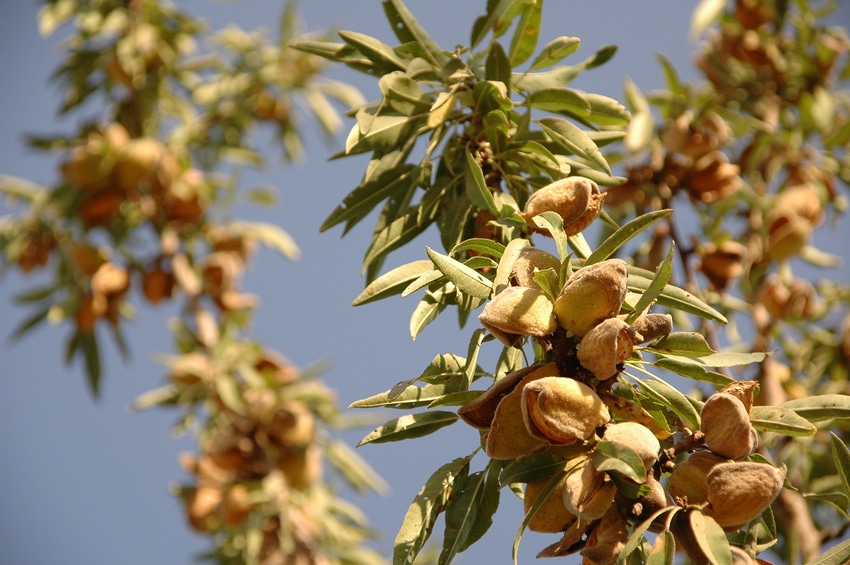
Two developments are helping drive the research. The loss of cogeneration facilities in California is making it harder and more expensive to find homes for the wood materials. And the value of hulls has significantly declined as the demands from the California dairy industry are decreasing while almond hull production is increasing.
September 14, 2016

The almond industry is stepping up research efforts to find alternate uses for almond byproducts that could bring added value going well beyond the value for the nuts.
Almond hulls may be used to produce food grade sugars that could replace high fructose corn syrup. Shells could become a soil conditioner, or could find their way into plastics or even into baby diapers as an absorbent.
Huge machines could recycle whole trees with favorable impacts on soil health.
Two developments are helping drive the research. The loss of cogeneration facilities in California is making it harder and more expensive to find homes for the wood materials. And the value of hulls has significantly declined as the demands from the California dairy industry are decreasing while almond hull production is increasing.
“Three years ago growers were getting $150 a ton for hulls which were fed to cows,” says Bill Ort, bioproducts research leader with the U.S. Department of Agriculture in Albany, Calif. “They were trucked to Harris farms, and the cows were happy.
“But now, the dairy and meat industry are down, and the amount of almonds is up 5 to 10 percent a year. The trees are there; the cows are not there.”
In an address to the Almond Board of California (ABC), Orts said almond biomass in California amounts to 2.4 million tons a year. Eighteen percent is trees, 53 percent is hulls, shells are 22 percent, and the rest is prunings and twigs.
Orts says hulls could compete with sugar beets in the production of sugars, and the Nonpareil variety, the most widely planted, is highest in “free sugars.” He says equipment used by the sugar beet industry could be used on the hulls and would be “cost effective.”
That’s not the case with ethanol production. The grower would have a large cost reduction per ton, he says, and ethanol plants cost millions of dollars to build.
“It would be a big gamble,” says Orts.
An anaerobic digester could extract biogas from hulls.
Hulls are super absorbent, he says, sopping up 10 times their weight in water. They could be used to reduce dust or as natural absorbents in diapers. Biochar material made from shells or hulls can be used to condition soil.
An almond processing plant in Los Banos has built an eight-ton- per-day unit to produce what Orts calls “biocoal” on location, moving from orchard to orchard on an 18-wheel trailer.
Biocoal would be a soil amendment that helps retain carbon. It could be pelletized and taken to a utility company for making electricity. Or it could be added to plastics to add color, while making plastics lighter and more durable, changing the melting point. It could also be used in tires.
In addition to investing in research, the ABC is working closely with Almond Alliance of California, formerly the Almond Hullers and Processors Association, to seek state legislative and regulatory solutions to the state’s management of wood materials.
Many biomass plants have closed or are closing since it cost less to produce electricity with solar and wind, which get subsidies not available to biomass.
Biomass plants have shut down in Delano, Mendota, Firebaugh, Dinuba, and Terra Bella, leaving a handful in the San Joaquin Valley. The challenge of disposal of dying trees in the forests has sparked plans to build smaller biomass plants in the Sierra.
Given the decline of cogeneration plants, the Almond Board has granted an expert team lead by Brent Holtz, a University of California researcher, $145,000 to explore the feasibility of whole almond orchard recycling.
Holtz has looked at efforts to recycle orchard biomass back into the soil using specialized equipment like the Iron Wolf. He said that research centers on the benefits of putting orchard debris back into the ground compared to the negatives.
While he said the benefits of whole orchard recycling appear clear, the cost of this type of recycling has been a challenge.
“Nobody (in the industry) has purchased a $1.3 million machine to crush rock,” he said, “and it costs $52,000 per month to rent one. But if enough people rent them, the price per machine could go down noticeably.”
He believes rental costs could go as low as $1,000 per acre, provided growers keep the chips that are created. And he adds that cogeneration plant closures, along with global interest in combating climate change, are serving as incentives for recycling old orchards.
Previous research has shown that recycling debris “adds carbon to the soil,” Holtz says. In time, growers may possibly benefit from adding carbon to the soil because of cap and trade benefits they may receive.
“There’s the potential growers would get reimbursed,” says Holtz.
Gabrielle Ludwig, the board’s director of sustainability and environmental affairs, said UC and the USDA have developed some value-added chemistry processes for almond byproducts that need field testing.
“A number of private companies have contacted the Almond Board about using almond byproducts, including wood, hulls, and shells,” she says.
Ludwig adds that many questions remain about the new processes. These include how the carbon footprint for the processes compares to current cogeneration systems and the amount of investment required.
“With all of these possible approaches, we need to figure out how to make them usable under a wide range of circumstances and sort out any possible regulatory issues,” Ludwig says. “This will take time.”
You May Also Like



